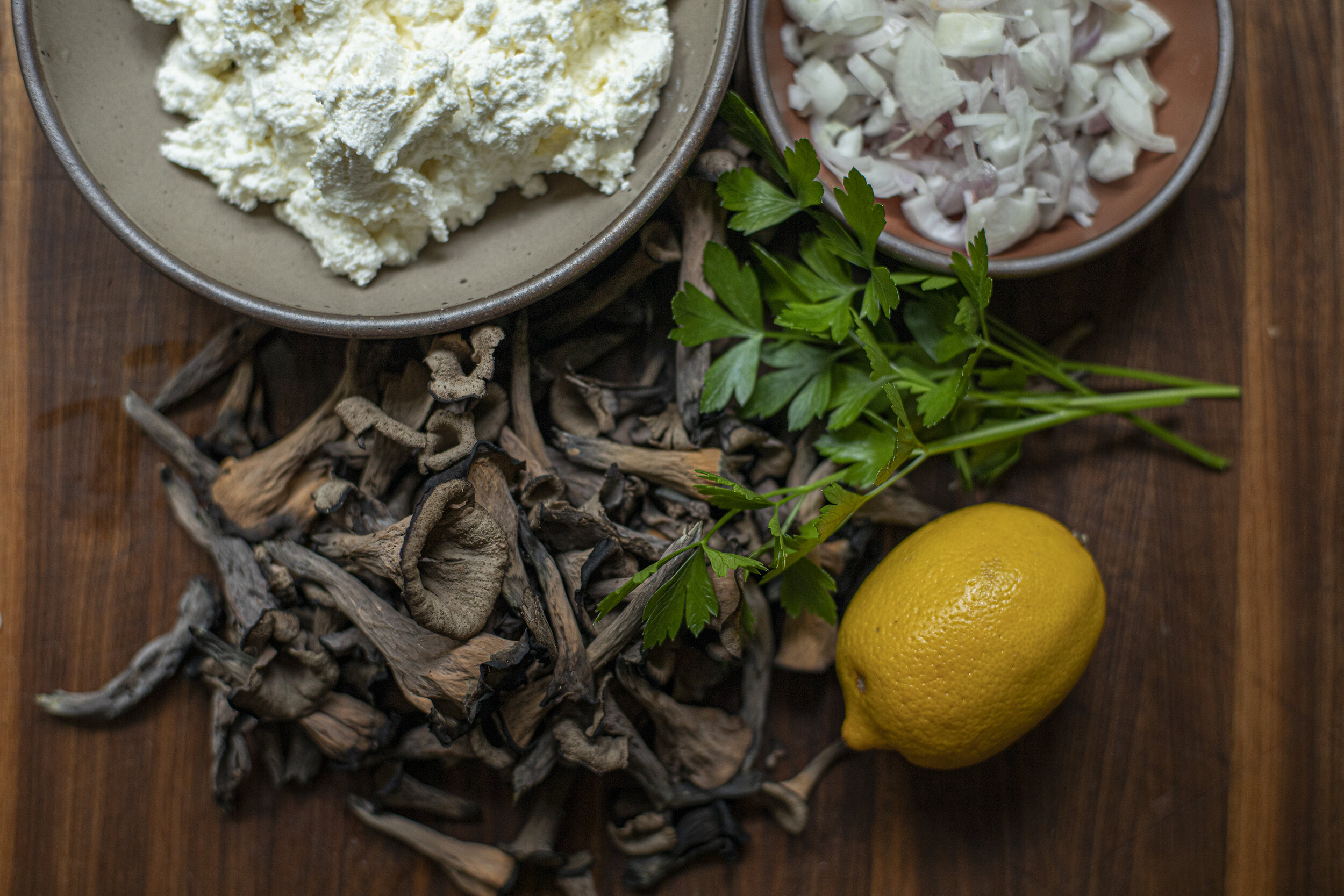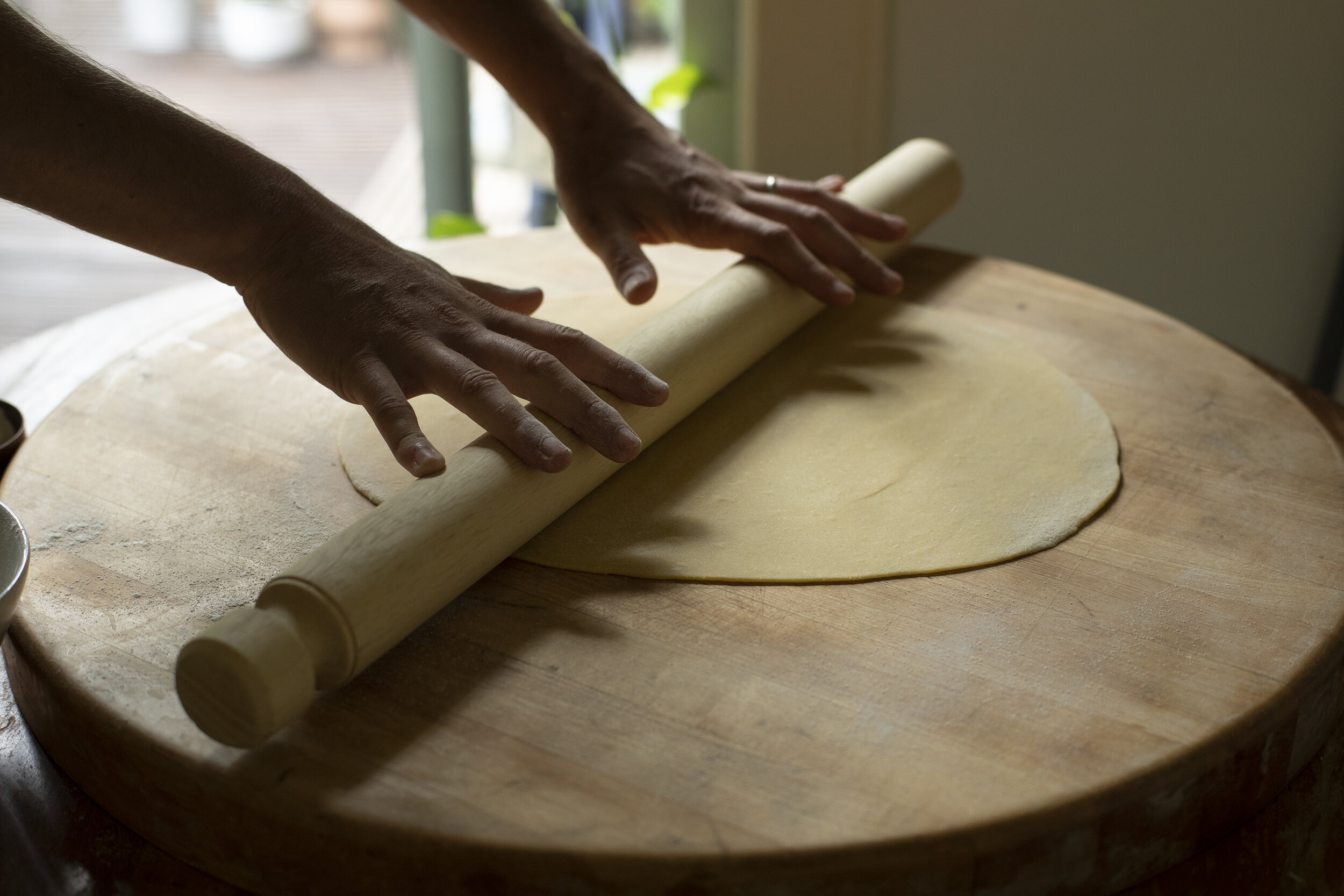Black Trumpet Ravioli with Sage Cream Sauce
Black trumpet ravioli filled with sautéed black trumpets & shallots, parsley, lemon zest, and fresh ricotta served with a creamy sage butter sauce and cracked black pepper. Simple and decadent, meant to showcase one of the most unique wild mushrooms available this time of year. The smell of fresh trumpets are hard to define; earthy, floral, almost intoxicating. I always enjoy thinking of new ways to cook with them. A short video of the process is below.
The Filling
Ingredients:
Fresh black trumpet mushrooms (about 2 cups)
Ricotta (2 cups drained of excess liquid)
2-3 Shallots (finely minced)
Zest of 1 lemon
Parsley (handful)
Olive oil
Directions:
Bring a skillet to medium heat and add a few tablespoons of olive oil.
Add the shallots and saute for about 5 minutes until softened and golden, constantly stirring.
Add the mushrooms and continue to cook down for another 5 minutes until well incorporated.
Season with a little salt and pepper.
Remove from the skillet and set aside to cool.
In a food processor, add the mushroom/shallot mix and parsley and pulse a few times for a a few seconds. The result should be a mix that is finely chopped (NOT completely blitzed into a puree).
Remove from the processor and mix together with the ricotta and lemon zest.
Season with salt to taste.
Cover and set aside (in refrigerator) until ready to fill the ravioli.
The Pasta
Ingredients
454 g 00 Flour
258 g eggs (beaten before mixing)
1 extra egg (beaten for sealing)
*Portioned for 5 - 6 people
Directions
Dump the weighed flour onto a clean work surface.
Use your hand to form a well (like a volcano) in the center of the flour.
Carefully pour your eggs into the center and begin slowly mixing together with a fork. Gradually, carefully, work your way all around to incorporate the eggs with the flour, without breaking the outer wall.
After about 5 - 10 minutes it will start coming together into a shaggy mass. Begin using your hands to knead the dough together. Work diligently for another 5 minutes until it is no longer shaggy.
Use the edges of your hands, knuckles, to work the dough until it starts to form a smooth ball. Roll it, applying pressure, into the work surface. Fold it. Roll it again. After about ten minutes it should be a smooth, and ready to rest.
Cut the dough into two and wrap each in plastic wrap. Set into the fridge for at least 30 minutes.
The following steps revolve around using a pasta attachment on a Kitchenaid - but you could also do this by hand with a rolling pin. Remove one of the dough balls, unwrap, and cut off a portion of the dough. Lightly flour and cover the rest back with plastic. Press gently and form a rectangle.
Pass the dough through the sheet pasta attachment at it’s widest setting. If it feels sticky, add a little more flour. Gradually tighten the settings of the pasta attachment, one click at a time, and pass the pasta sheet through until it is light and delicate. For ravioli, I normally go to the 6th setting.
Cut off any irregular ends and you should be left with a long sheet of sfoglia that is about 5-6 inches thick.
My method is best visualized in the video below - and this is only one way to do it. There are many other much more skilled pasta makers out there who likely would recommend doing it another way - but this was my approach. This method involves folding the sheet of dough over on to itself vs using two different sheets stacked on top of each other.
Using a spoon and your finger tips, carefully place a dollop of filling about the size of the tip of your pinky - in one corner of the sfoglia. Leave about a half to 3/4 inch of space on either side to the edge. Continue placing the dollops of filling along one entire side of the rectangle.
Brush on a light coating of egg wash around the filling and along the edge of the sfoglia.
Carefully fold over the exposed half of the sfoglia onto the other half, covering the filling. Use your fingers to gently press down around the mounds of filling, pushing out any air pockets to the other edge. Work intentionally to eliminate any remaining air pockets.
Using a scalloped pasta cutter - trim off the outer edges - but leaving the folded edge in tact.
Now cut between each individual ravioli with the cutter until you have none left.
Gently dust with semolina, and transfer to a pan with semolina sprinkled on the bottom to avoid sticking. Allow to air dry for about 10 minutes and transfer to the refrigerator until ready to cook.
Repeat the process until you have no more dough or no more filling left.
The Sauce & Final Dish
Ingredients:
1 Cup heavy cream
3 tbsp butter
1/2 cup grated pecorino Romano
1 tbsp very finely minced sage
Pasta water as necessary
Directions:
You should make the sauce right before you drop the ravioli into the boiling water. This step only takes a few minutes and you don’t want the sauce sitting around.
Melt the butter in a skillet on medium heat.
Add the finely minced sage and stir into the butter, cooking for a minute or two.
Add the heavy cream and continue to stir so nothing sticks to the bottom of the pan.
Add the grated pecorino Romano and continue to stir as the sauce begins to thicken.
Add pasta water to adjust the consistency of the sauce, a few tablespoons at a time. This will also help make the sauce more silky.
Add the ravioli to salted boiling water. The fresh pasta will only take about 3-4 minutes to cook. Continue simmering your sauce.
Remove the sauce from the heat and add the cooked/drained ravioli directly to the pan. Using a large spoon, stir together, completely coating all of the ravioli with sauce.
Plate each serving and finish with a sprinkle of more freshly grated pecorino and fresh cracked black pepper.

















